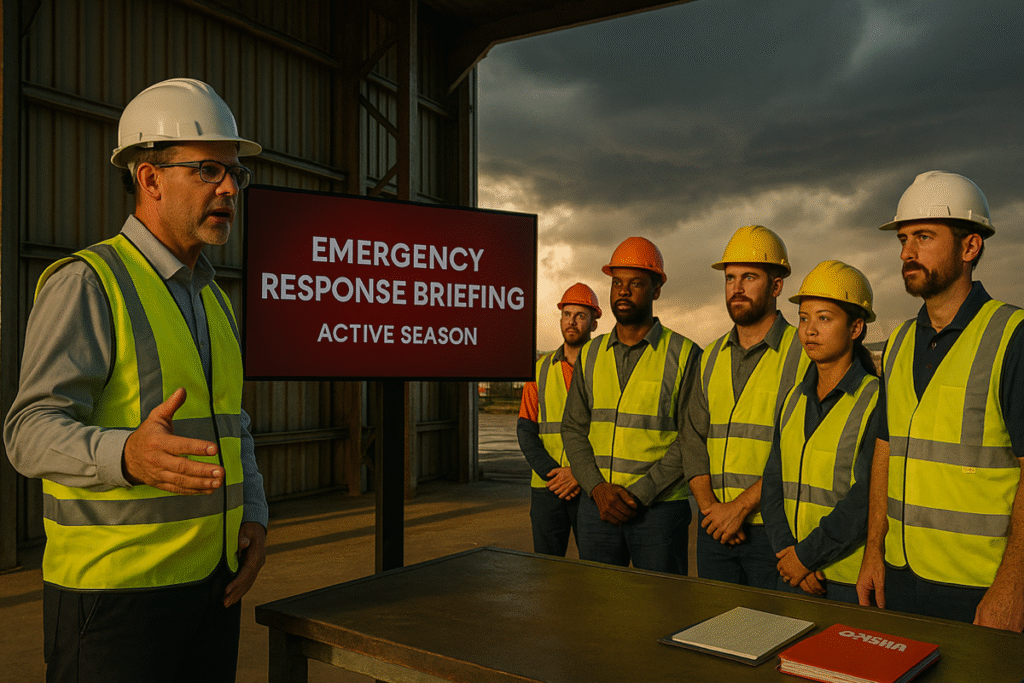
Expanding EHS Leadership Presence During Natural Disaster Season

Natural disaster season compresses decisions, magnifies risk, and tests whether safety leadership shows up where it matters on the ground, in real time. When Environmental, Health, and Safety (EHS) leaders expand their presence before, during, and after severe weather, organizations cut downtime, protect people, and keep projects moving. NOAA’s 2025 Atlantic outlook projects an above-normal season, sharpening the need for proactive leadership that turns forecasts into actionable plans for construction sites, transportation fleets, general industry facilities, and environmental operations (National Oceanic and Atmospheric Administration, 2025; NOAA, 2025, August update).
OSHA’s emergency preparedness framework makes clear that planning, training, and communication must be in place before an incident, with workers equipped and briefed on where to go and how to stay safe when conditions deteriorate (Occupational Safety and Health Administration, 2025-a; OSHA, 2025.-b). EHS leaders translate those requirements into visible actions: staging brief “just-in-time” refreshers, verifying muster points, and aligning contractors and owners on shut-down and restart criteria. For response and recovery, NIOSH’s Emergency Responder guidance and the ERHMS framework emphasize protecting responders across pre-deployment, deployment, and post-deployment phases, including appropriate PPE, health monitoring, and hazard controls practices EHS must champion at every site (National Institute for Occupational Safety and Health, 2024 – a; NIOSH, 2024 – b).
Business continuity depends on more than sandbags and generators. FEMA’s Continuity Resource Toolkit specifies how organizations identify essential functions, assign leadership roles, and sustain critical services when normal operations are disrupted, tying EHS leadership directly to continuity planning and exercises (Federal Emergency Management Agency, 2025). For transportation-dependent operations, DOT’s climate adaptation planning underscores the need to integrate extreme-weather risk into budgets, projects, and operations so that routes, depots, and suppliers are resilient enough to support safe work during and after events (U.S. Department of Transportation, 2024).
The four pillars of safety come alive in this season. Safety and health training becomes targeted surge training for severe weather. Hazard prevention and control means hardening sites, verifying ventilation and power contingencies, and controlling chemical and environmental risks during shut-down and restart. Worksite analysis shifts to rapid, repeated checks as conditions evolve. Management commitment and employee involvement are visible when leaders show up on the floor, amplify trusted channels, and close the loop on corrective actions quickly. At Key Safety LLC, we operationalize these pillars through Document Development for Start-up Projects that embed OSHA, NIOSH, FEMA, and DOT guidance into site-specific SOPs; Service on Demand for pre-storm drills, damage-assessment playbooks, and restart safety; and Regular Consultation Service to align annual plans with current NOAA outlooks and continuity requirements.
Expanding EHS leadership presence during natural disaster season is not an extra it is the difference between improvisation and resilience. When leaders are visible, prepared, and connected to the work, organizations protect people, maintain compliance, and earn trust through every storm.
References
Federal Emergency Management Agency. (2025, February 19). Continuity resource toolkit. https://www.fema.gov/emergency-managers/national-preparedness/continuity
National Institute for Occupational Safety and Health. (2024, April 12). Safety guidelines: Emergency response and recovery workers. Centers for Disease Control and Prevention. https://www.cdc.gov/niosh/emres/safety/index.html
National Institute for Occupational Safety and Health. (2024, April 12). Protecting emergency response and recovery workers (ERHMS overview). Centers for Disease Control and Prevention. https://www.cdc.gov/niosh/emres/about/index.html
National Oceanic and Atmospheric Administration. (2025, May 22). NOAA predicts above-normal 2025 Atlantic hurricane season. https://www.noaa.gov/news-release/noaa-predicts-above-normal-2025-atlantic-hurricane-season
National Oceanic and Atmospheric Administration. (2025, August 7). Prediction remains on track for above-normal Atlantic hurricane season. https://www.noaa.gov/news-release/prediction-remains-on-track-for-above-normal-atlantic-hurricane-season
Occupational Safety and Health Administration. (2025-a). Emergency preparedness and response. U.S. Department of Labor. https://www.osha.gov/emergency-preparedness
Occupational Safety and Health Administration. (2025-b). Emergency preparedness and response: Getting started. U.S. Department of Labor. https://www.osha.gov/emergency-preparedness/getting-started
U.S. Department of Transportation. (2024, June 20). U.S. DOT climate adaptation plan 2024–2027 [PDF]. https://www.sustainability.gov/pdfs/dot-2024-cap.pdf
Comments:

